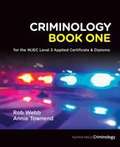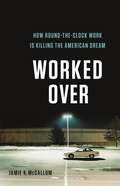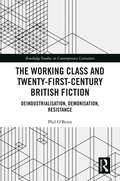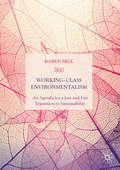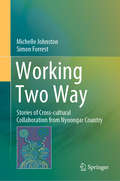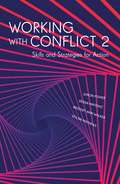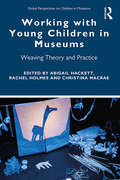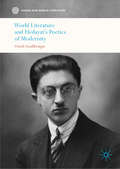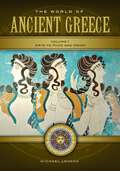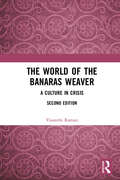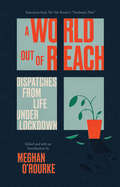- Table View
- List View
Workbook for Criminology: Book One
by Rob Webb Annie TownendThis is a student workbook to accompany Criminology Book One for the WJEC Level 3 Applied Certificate and Diploma published by Napier Press.
Worked Over: How Round-the-Clock Work Is Killing the American Dream
by Jamie K McCallumAn award-winning sociologist reveals the unexpected link between overwork and inequality.Most Americans work too long and too hard, while others lack consistency in their hours and schedules. Work hours declined for a century through hard-fought labor-movement victories, but they've increased significantly since the seventies. Worked Over traces the varied reasons why our lives became tethered to a new rhythm of work, and describes how we might gain a greater say over our labor time -- and build a more just society in the process.Popular discussions typically focus on overworked professionals. But as Jamie K. McCallum demonstrates, from Amazon warehouses to Rust Belt factories to California's gig economy, it's the hours of low-wage workers that are the most volatile and precarious -- and the most subject to crises. What's needed is not individual solutions but collective struggle, and throughout Worked Over McCallum recounts the inspiring stories of those battling today's capitalism to win back control of their time.
Workers, Unions and Payment in Kind: The Fight for Real Wages in Britain, 1820–1914 (Perspectives in Economic and Social History)
by Christopher FrankDespite the dramatic expansion of consumer culture from the beginning of the eighteenth century onwards and the developments in retailing, advertising and credit relationships in the nineteenth and twentieth centuries, there were a significant number of working families in Britain who were not fully free to consume as they chose. These employees were paid in truck, or in goods rather than currency. This book will explore and analyse the changing ways that truck and workplace deductions were experienced by different groups in British society, arguing that it was far more common than has previously been acknowledged. This analysis brings to light issues of class and gender; the discourse of free trade, popular politics and protest; the development of the trade union movement; and the use of the legal system as an instrument for bringing about social and legal change.
Workers, Unions and Payment in Kind: The Fight for Real Wages in Britain, 1820–1914 (Perspectives in Economic and Social History)
by Christopher FrankDespite the dramatic expansion of consumer culture from the beginning of the eighteenth century onwards and the developments in retailing, advertising and credit relationships in the nineteenth and twentieth centuries, there were a significant number of working families in Britain who were not fully free to consume as they chose. These employees were paid in truck, or in goods rather than currency. This book will explore and analyse the changing ways that truck and workplace deductions were experienced by different groups in British society, arguing that it was far more common than has previously been acknowledged. This analysis brings to light issues of class and gender; the discourse of free trade, popular politics and protest; the development of the trade union movement; and the use of the legal system as an instrument for bringing about social and legal change.
The Working Class and Twenty-First-Century British Fiction: Deindustrialisation, Demonisation, Resistance (Routledge Studies in Contemporary Literature)
by Phil O'BrienThe Working Class and Twenty-First-Century British Fiction looks at how the twenty-first-century British novel has explored contemporary working-class life. Studying the works of David Peace, Gordon Burn, Anthony Cartwright, Ross Raisin, Jenni Fagan, and Sunjeev Sahota, the book shows how they have mapped the shift from deindustrialisation through to stigmatization of individuals and communities who have experienced profound levels of destabilization and unemployment. O'Brien argues that these novels offer ways of understanding fundamental aspects of contemporary capitalism for the working class in modern Britain, including, class struggle, inequality, trauma, social abjection, racism, and stigmatization, exclusively looking at British working-class literature of the twenty-first century.
The Working Class and Twenty-First-Century British Fiction: Deindustrialisation, Demonisation, Resistance (Routledge Studies in Contemporary Literature)
by Phil O'BrienThe Working Class and Twenty-First-Century British Fiction looks at how the twenty-first-century British novel has explored contemporary working-class life. Studying the works of David Peace, Gordon Burn, Anthony Cartwright, Ross Raisin, Jenni Fagan, and Sunjeev Sahota, the book shows how they have mapped the shift from deindustrialisation through to stigmatization of individuals and communities who have experienced profound levels of destabilization and unemployment. O'Brien argues that these novels offer ways of understanding fundamental aspects of contemporary capitalism for the working class in modern Britain, including, class struggle, inequality, trauma, social abjection, racism, and stigmatization, exclusively looking at British working-class literature of the twenty-first century.
Working-Class Environmentalism: An Agenda for a Just and Fair Transition to Sustainability
by Karen BellThis book presents a timely perspective that puts working-class people at the forefront of achieving sustainability. Bell argues that environmentalism is a class issue, and confronts some current practice, policy and research that is preventing the attainment of sustainability and a healthy environment for all. She combines two of the biggest challenges facing humanity: that millions of people around the world still do not have their social and environmental needs met (including healthy food, clean water, affordable energy, clean air); and that the earth’s resources have been over-used or misused. Bell explores various solutions to these social and ecological crises and lays out an agenda for simultaneously achieving greater well-being, equality and sustainability. The result will be an invaluable resource for practitioners and policy-makers working to achieve environmental and social justice, as well as to students and scholars across social policy, sociology, human geography, and environmental studies.
Working Donkeys in 4th-3rd Millennium BC Mesopotamia: Insights from Modern Development Studies (UCL Institute of Archaeology Publications)
by Jill GoulderWorking Donkeys in 4th-3rd Millennium BC Mesopotamia: Insights from Modern Development Studies is a reassessment of the role and impact of working-animal adoption in antiquity, focusing on 4th-3rd millennium BC Mesopotamia but applicable to other periods and regions. This book is driven by a novel interdisciplinary process of analogy with modern use of working donkeys and cattle in sub-Saharan Africa and elsewhere. The author uses close qualitative analysis of nearly 400 published official and NGO development studies of the complex practicalities of adoption of working animals in developing regions worldwide, in particular of the invisible and under-appreciated donkey. This material, little-used as yet in Ancient Near Eastern archaeology, sheds light on the day-to-day practicalities of working-animal adoption and management – breeding, training, husbandry, hiring and lending. While archaeology will always have need of large-scale anthropological models, the author argues for a parallel bottom-up ethological approach, envisaging the 4th and 3rd millennia BC in Mesopotamia from a viewpoint explicitly acknowledging the major presence of working animals and their daily impact on human activity and the consequent archaeological record. This innovatory investigation of the role and impact of the donkey in the Ancient Near East and today is an essential handbook for Ancient Near Eastern archaeology and zooarchaeology researchers and students, as well as historians, anthropologists and ethnographers examining the impact of working animals on past and present societies. Wider audiences include the growing sector of human-animal relationship studies, and NGOs concerned with the use of working donkeys worldwide.
Working Donkeys in 4th-3rd Millennium BC Mesopotamia: Insights from Modern Development Studies (UCL Institute of Archaeology Publications)
by Jill GoulderWorking Donkeys in 4th-3rd Millennium BC Mesopotamia: Insights from Modern Development Studies is a reassessment of the role and impact of working-animal adoption in antiquity, focusing on 4th-3rd millennium BC Mesopotamia but applicable to other periods and regions. This book is driven by a novel interdisciplinary process of analogy with modern use of working donkeys and cattle in sub-Saharan Africa and elsewhere. The author uses close qualitative analysis of nearly 400 published official and NGO development studies of the complex practicalities of adoption of working animals in developing regions worldwide, in particular of the invisible and under-appreciated donkey. This material, little-used as yet in Ancient Near Eastern archaeology, sheds light on the day-to-day practicalities of working-animal adoption and management – breeding, training, husbandry, hiring and lending. While archaeology will always have need of large-scale anthropological models, the author argues for a parallel bottom-up ethological approach, envisaging the 4th and 3rd millennia BC in Mesopotamia from a viewpoint explicitly acknowledging the major presence of working animals and their daily impact on human activity and the consequent archaeological record. This innovatory investigation of the role and impact of the donkey in the Ancient Near East and today is an essential handbook for Ancient Near Eastern archaeology and zooarchaeology researchers and students, as well as historians, anthropologists and ethnographers examining the impact of working animals on past and present societies. Wider audiences include the growing sector of human-animal relationship studies, and NGOs concerned with the use of working donkeys worldwide.
Working in Greece and Turkey: A Comparative Labour History from Empires to Nation-States, 1840–1940 (International Studies in Social History #33)
by Leda Papastefanaki M. Erdem KabadayıAs was the case in many other countries, it was only in the early years of this century that Greek and Turkish labour historians began to systematically look beyond national borders to investigate their intricately interrelated histories. The studies in Working in Greece and Turkey provide an overdue exploration of labour history on both sides of the Aegean, before as well as after the fall of the Ottoman Empire. Deploying the approaches of global labour history as a framework, this volume presents transnational, transcontinental, and diachronic comparisons that illuminate the shared history of Greece and Turkey.
Working Two Way: Stories of Cross-cultural Collaboration from Nyoongar Country
by Michelle Johnston Simon ForrestThis book describes an action research approach to engaging respectfully with First Nations communities in a diverse range of contexts, disciplines and projects. It offers a valuable guide for professionals, students and teaching staff that recognises all participants as equal partners while acknowledging the diversity of First Peoples and culture, and prioritising local knowledge. While the book is adaptable to a diverse range of cultures and disciplines, it is specifically focused on cross-cultural collaborative case studies in Noongar Country, which is located in the southwest of Western Australia. The case studies demonstrate how action research can be applied not only in the traditional areas of education and social justice, but also in a diverse range of disciplines, communities and circumstances, including media, education, environmental management and health. The book’s aim is to highlight successful cross-cultural First Nations community projects and to discuss each one in terms of its action research philosophy and process. In this regard, the voices of the participants are prioritised, especially those of First Nations communities. While this book is specifically pitched at Australian readers, the action research approach described may be adapted and applied to many cross-cultural collaborative relationships, making it of interest and value to international students and researchers.
Working with Conflict 2: Skills and Strategies for Action
by Simon Fisher Vesna Matovic Bridget Ann Walker Dylan MathewsWorking with Conflict 2 reflects the accumulated wisdom of over 3000 peacebuilding practitioners from 70 countries over the 20 years since the first Working with Conflict book was published. Its focus is on understanding and transforming conflict, building practical strategies for constructive change, analysing power, addressing violence, healing wounds and building movements for change. It is relevant to all who are trying to bring about change in intractable situations, from grassroots to policy level, including those working in the fields of peacebuilding, humanitarian assistance, development, climate change, human rights, gender equality, trauma healing and democracy.Working with Conflict 2 is an accessible practical resource, for both individuals and organisations working and researching how to work in conflict-prone and unstable parts of the world. Easy to use, including helpful visual materials, it provides a range of practical tools – processes, ideas, techniques – for tackling conflict, as well as providing links to other key conflict-related and peacebuilding resources, including organisations, publications and websites.
Working with Young Children in Museums: Weaving Theory and Practice (Global Perspectives on Children in Museums)
by Rachel Holmes Abigail Hackett Christina MacRaeWorking with Young Children in Museums makes a major contribution to the small body of extant research on young children in museums, galleries and heritage sites. Bridging theory and practice, the book introduces theoretical concepts in a clear and concise manner, whilst also providing inspirational insights into everyday programming in museums. Structured around three key themes, this volume seeks to diverge from the dominant socio-cultural learning models that are generally employed in the museum learning literature. It introduces a body of theories that have variously been called new materialist, spatial, posthuman and Deleuzian; theories which enable a focus on the body, movement and place and which have not yet been widely shared or developed with the museum sector or explicitly connected to practice. This book outlines these theories in an accessible way, explaining their usefulness for conceptualising young children in museums and connecting them to practical examples of programming in a range of locations via a series of contributed case studies. Connecting theory to practice for readers in a way that emphasises possibility, Working with Young Children in Museums should be essential reading for museum practitioners working in a range of institutions around the world. It should be of equal interest to researchers and students engaged in the study of museum learning, early childhood education and children’s experiences in museums.
Working with Young Children in Museums: Weaving Theory and Practice (Global Perspectives on Children in Museums)
by Rachel Holmes Abigail Hackett Christina MacRaeWorking with Young Children in Museums makes a major contribution to the small body of extant research on young children in museums, galleries and heritage sites. Bridging theory and practice, the book introduces theoretical concepts in a clear and concise manner, whilst also providing inspirational insights into everyday programming in museums. Structured around three key themes, this volume seeks to diverge from the dominant socio-cultural learning models that are generally employed in the museum learning literature. It introduces a body of theories that have variously been called new materialist, spatial, posthuman and Deleuzian; theories which enable a focus on the body, movement and place and which have not yet been widely shared or developed with the museum sector or explicitly connected to practice. This book outlines these theories in an accessible way, explaining their usefulness for conceptualising young children in museums and connecting them to practical examples of programming in a range of locations via a series of contributed case studies. Connecting theory to practice for readers in a way that emphasises possibility, Working with Young Children in Museums should be essential reading for museum practitioners working in a range of institutions around the world. It should be of equal interest to researchers and students engaged in the study of museum learning, early childhood education and children’s experiences in museums.
Working with Young People: A Social Pedagogy Perspective from Europe and Latin America (Social Justice and Youth Community Prac)
by Xavier Úcar, Pere Soler-Masó, Anna Planas-LladóWorking with Young People offers a new outlook on social, cultural, and educational work with young people. It utlizes the perspective of social pedagogy--a theoretical and practical perspective that has been developing in continental Europe over the last 150 years--in placing young people at the center of socio-educational work and giving value to their decisions and actions. The text supports youths' process of personal construction within the framework of the community in which they live. The book is organized into three large blocks of chapters. The introduction aims to prepare readers for the social pedagogy approach to work with young people. It briefly outlines its current situation in the world and, relate it to the main professions in which it is embodied in different socio-cultural contexts: social pedagogy, social education, and social work. The first block presents the framework and socio-pedagogical, theoretical, and practical parameters in which work with young people takes place in Europe and Latin America. The second block of chapters deals with youth policies and the training and professionalization of educators and those who work with young people. The last block focuses on some socio-educational practices with young people that include youth justice, social inclusion process, youth participation in digital life or transition to adult life. The book is based on a wide perspective of young people from cultural diversity.
World Health Systems
by Xiaoming SunYour all-in-one companion for health personnel World Health Systems details different health systems, including their related health insurance and drug supply systems, in various parts of the world with both macro- and micro- perspectives. The book is arranged in five parts: the first part presents, from multidisciplinary perspectives, outlines of various health systems throughout the world, as well as current trends in the development and reform of world health systems. The second and third parts expound on the health systems in developed countries, discussing the government's role in the health service market and basic policies on medication administration and expenses, before analyzing the health systems of Britain, Canada, Australia, Sweden, Germany, France, Japan, Poland, USA, Singapore, Hongkong (China), and Taiwan (China). The fourth and fifth parts discuss health systems in less developed countries and areas, typically the BRICS and other countries in Asia (Thailand, Vietnam, the Philippines, Armenia, and Kyrghyzstan), Africa (Egypt, Morocco), Europe (Hungary, Czech Republic, and Bulgaria) and South America (Cuba, Chile, and Mexico), summarizing their past experiences, while making assessments of their current efforts to shed light on future developments. Details a variety of health systems throughout the world Compares their fundamental features and characteristics Discusses their respective strengths and shortcomings Provides insight from an author who holds multiple impressive titles in the health sector Public health professionals and academics alike will want to add World Health Systems to their library.
World Health Systems
by Xiaoming SunYour all-in-one companion for health personnel World Health Systems details different health systems, including their related health insurance and drug supply systems, in various parts of the world with both macro- and micro- perspectives. The book is arranged in five parts: the first part presents, from multidisciplinary perspectives, outlines of various health systems throughout the world, as well as current trends in the development and reform of world health systems. The second and third parts expound on the health systems in developed countries, discussing the government's role in the health service market and basic policies on medication administration and expenses, before analyzing the health systems of Britain, Canada, Australia, Sweden, Germany, France, Japan, Poland, USA, Singapore, Hongkong (China), and Taiwan (China). The fourth and fifth parts discuss health systems in less developed countries and areas, typically the BRICS and other countries in Asia (Thailand, Vietnam, the Philippines, Armenia, and Kyrghyzstan), Africa (Egypt, Morocco), Europe (Hungary, Czech Republic, and Bulgaria) and South America (Cuba, Chile, and Mexico), summarizing their past experiences, while making assessments of their current efforts to shed light on future developments. Details a variety of health systems throughout the world Compares their fundamental features and characteristics Discusses their respective strengths and shortcomings Provides insight from an author who holds multiple impressive titles in the health sector Public health professionals and academics alike will want to add World Health Systems to their library.
World Literature and Hedayat’s Poetics of Modernity (Canon and World Literature)
by Omid AzadibougarThis book introduces the canonical figure Sadegh Hedayat (1903–1951) and draws a comprehensive image of a major intellectual force in the context of both modern Persian Literature and World Literature. A prolific writer known for his magnum opus, The Blind Owl (1936), Hedayat established the use of common language for literary purposes, opened new horizons on imaginative literature and explored a variety of genres in his creative career. This book looks beyond the reductive critical tendencies that read a rich and diverse literary profile in light of Hedayat’s suicide, arguing instead that his literary imagination was not solely the result of genius but rather enriched by a vast network of the world’s literary traditions. This study reflects on Hedayat’s attempts at various genres of artistic creation, including painting, fiction writing, satire and scholarly research, as well as his persistent struggles for artistic authenticity, which transcended solidly established literary and artistic norms. Providing a critical reading of Hedayat’s work to untangle aspects of his writing – including reflections on science, religion, nationalism and coloniality – alongside his pioneering work on folk culture, and how humor informs his writings, this text offers a critical review of the status of Persian literature in the contemporary landscape of the world’s literary studies.
World Mythology: From Indigenous Tales to Classical Legends
by Tamsin Hughes'Mythology gives us a direct connection with our human lineage, taking us out of the bubble of our modern worlds and into a narrative where time is elastic.'This wondrous encyclopaedia gathers together over 100 myths from across the globe, featuring Mesopotamian creation stories, Roman legends, Norse epics, indigenous tales and more. These abridged stories open a window into the ancient landscapes, histories and beliefs that make up our cultural inheritance. These retellings include: • Asgard (Scandinavia) • Bran the Blessed (Britain) • Mount Olympus (Greece) • Four Horsemen of the Apocalypse (Middle East) Discover the roots of many recognizable characters, places and tales in each chapter. Made for easy reference, readers can thumb-through this illustrated treasure trove of parables, folktales and wonderful epics, derived from over 30 diverse cultures.
The World of Ancient Greece [2 volumes]: A Daily Life Encyclopedia [2 volumes] (Daily Life Encyclopedias)
by Michael LovanoThis book opens the world of the ancient Greeks to all readers through easily accessible entries on topics essential to understanding Greek high culture and daily life.The ancient Greeks provided the foundation for Western civilization. They made significant advances in science, mathematics, philosophy, literature, and government. While many readers might have heard of Plato and Aristotle, however, or be familiar with the classic works of Greek tragedy, most people know significantly less about daily life in the ancient Greek world. This encyclopedia opens the world of the ancient Greeks, spanning Greek history from the Bronze Age through Roman times, with an emphasis on the Classical and Hellenistic Eras.The encyclopedia provides roughly 270 easily accessible entries on topics essential to understanding everything from Greek high culture to daily life. These entries are grouped in topical sections on the arts, science and technology, politics and government, domestic life, and other subjects. Sidebars on particularly noteworthy people, places, and concepts provide related information, while primary documents allow readers to delve into the mindset and feelings of the ancient Greeks themselves. Extensive bibliographic references give curious readers direction for further research.
The World of Children: Foreign Cultures in Nineteenth-Century German Education and Entertainment (Studies in German History #24)
by Simone Lässig Andreas WeißIn an era of rapidly increasing technological advances and international exchange, how did young people come to understand the world beyond their doorsteps? Focusing on Germany through the lens of the history of knowledge, this collection explores various media for children—from textbooks, adventure stories, and other literature to board games, museums, and cultural events—to probe what they aimed to teach young people about different cultures and world regions. These multifaceted contributions from specialists in historical, literary, and cultural studies delve into the ways that children absorbed, combined, and adapted notions of the world.
The World of the Banaras Weaver: A Culture in Crisis
by Vasanthi RamanThis book is a fascinating investigation into how communalism plays out in everyday India. Using the metaphor of tana-bana – the warp and the weft of the Banarasi sari – the author reproduces the interwoven life of Hindu-Muslim relations in the Banarasi sari industry. As the city of Banaras in Uttar Pradesh takes the centre stage as the site of this ethnographic study, the author documents the dissonance in representations of Banaras as a sacred Hindu city and its essential plural character. The volume• examines in-depth the lives of Banaras Muslims in the social and economic matrix of the sari industry;• highlights how women negotiate between home, family and their place in the artisanal industry; and• sheds light on their fast-changing world of the Banaras weavers and their responses to it. With a new introduction and fresh data, the second edition looks at the subsequent developments in the weaving industry over the last decade. This volume will be of immense interest to scholars and researchers of social anthropology, gender studies, development studies, sociology and South Asian studies.
The World of the Banaras Weaver: A Culture in Crisis
by Vasanthi RamanThis book is a fascinating investigation into how communalism plays out in everyday India. Using the metaphor of tana-bana – the warp and the weft of the Banarasi sari – the author reproduces the interwoven life of Hindu-Muslim relations in the Banarasi sari industry. As the city of Banaras in Uttar Pradesh takes the centre stage as the site of this ethnographic study, the author documents the dissonance in representations of Banaras as a sacred Hindu city and its essential plural character. The volume• examines in-depth the lives of Banaras Muslims in the social and economic matrix of the sari industry;• highlights how women negotiate between home, family and their place in the artisanal industry; and• sheds light on their fast-changing world of the Banaras weavers and their responses to it. With a new introduction and fresh data, the second edition looks at the subsequent developments in the weaving industry over the last decade. This volume will be of immense interest to scholars and researchers of social anthropology, gender studies, development studies, sociology and South Asian studies.
A World Out of Reach: Dispatches from Life under Lockdown
by Meghan O’RourkeIn beautifully written and powerfully thought prose, A World Out of Reach offers a crucial record of the cataclysmic spring of 2020—a record for us to share with one another, and for posterity, in the voices of writers of disparate backgrounds. When the coronavirus outbreak came to the West, The Yale Review began asking writers to think out loud on the page about the unfolding international crisis, to capture the immediacy of a swiftly changing global pandemic. This crisis has mostly been told through the voices of journalists, scientists, and politicians, but in this collection, poets, essayists, scholars, and health care workers provide a more intimate and diverse account. Ranging from high matters of policy to ancient history to personal stories of how individuals were surviving their days, this vivid compilation presents a first draft of one of most tumultuous periods in modern history.Contributors: Katie Kitamura • Laura Kolbe • Nitin Ahuja • Natasha Randall • Rena Xu • Alicia Christoff • Miranda Featherstone • Maya C. Popa • Major Jackson • John Witt • Octávio Luiz Motta Ferraz • Joan Naviyuk Kane • Emmeline Clein • Nell Freudenberger • Briallen Hopper • Brandon Shimoda • Ben Purkert • Yusef Komunyakaa • Laren McClung • Eric O’Keefe-Krebs • Sean Lynch • Millicent Marcus • Meghana Mysore • Rachel Jamison Webster • Emily Ziff Griffin • Rowan Ricardo Philips • Kathryn Lofton • Monica Ferrell • Russell Morse • Randi Hutter Epstein • Noreen Khawaja • Victoria Chang • Joyelle McSweeney • Khameer Kidia • Emily Greenwood • Elisa Gabbert • Emily Bernard • Hafizah Geter • Emily Gogolak • Roger Reeves
World Prehistory: A Brief Introduction
by Brian M. Fagan Nadia DurraniThis popular introductory textbook provides an overview of more than 3 million years of human prehistory. Written in an accessible and jargon-free style, this engaging volume tells the story of humanity from our beginnings in tropical Africa up to the advent of the world’s first urban civilizations. A truly global account, World Prehistory surveys the latest advances in the study of human origins and describes the great diaspora of modern humans in the millennia that followed as they settled Europe, Asia, and the Americas. Later chapters consider seminal milestones in prehistory: the origins of food production, the colonization of the offshore Pacific, and the development of the first more complex human societies based, for the most part, on agriculture and stock raising. Finally, Fagan and Durrani examine the prevailing theories regarding early state-organized societies and the often flamboyant, usually volatile, preindustrial civilizations that developed in the Old World and the Americas. Fully updated to reflect new research, controversies, and theoretical debates, this unique book remains an ideal resource for the beginner first approaching archaeology. Drawing on the experience of two established writers in the field, World Prehistory is a respected classic that acquaints students with the fascinations of human prehistory.
